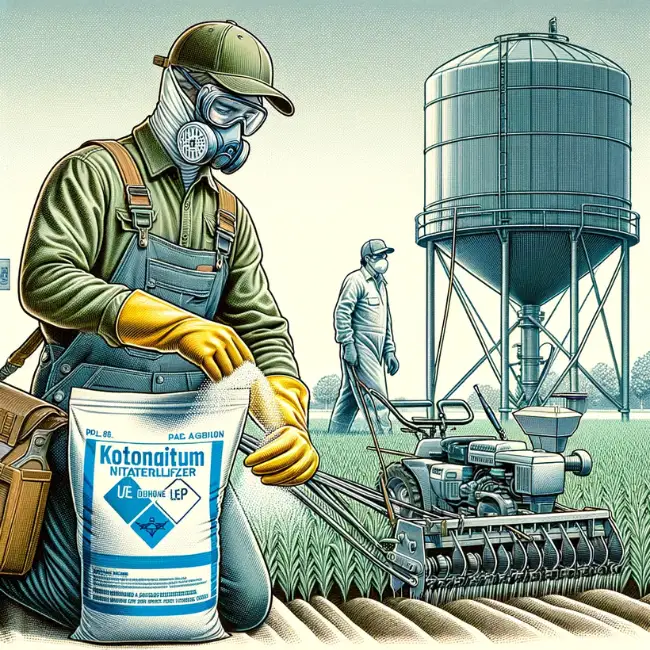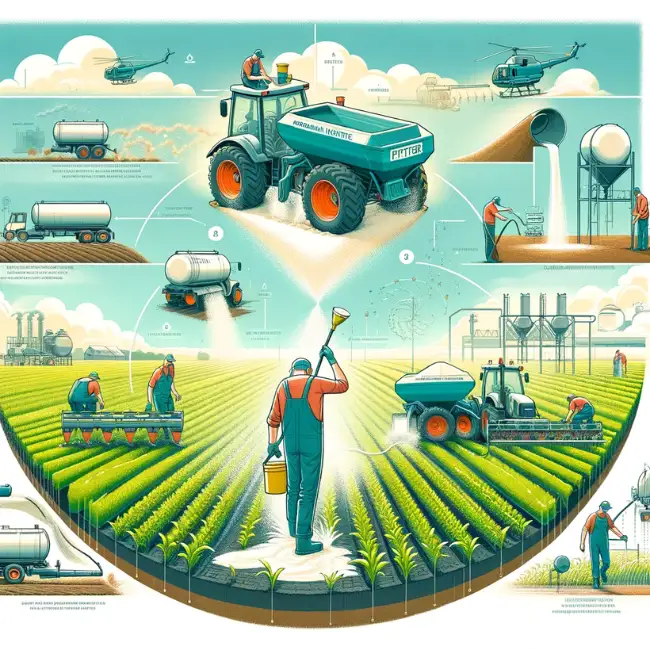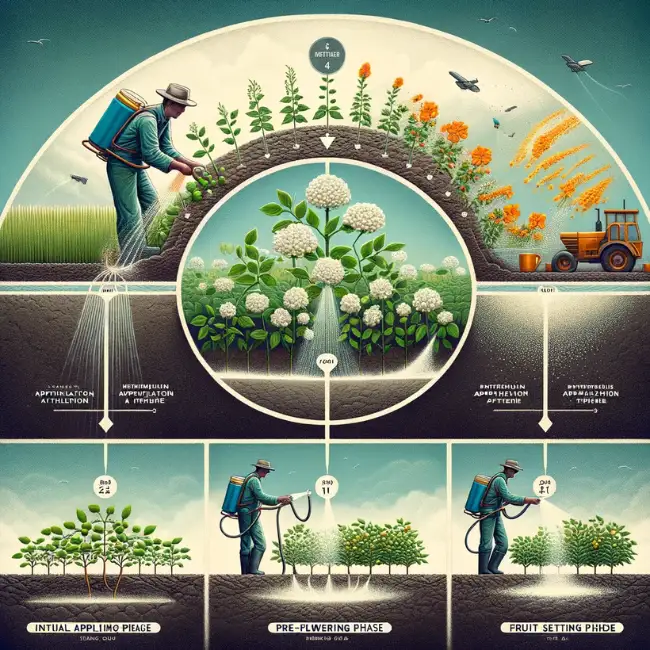Potassium nitrate, also known as saltpeter, is a powerful manure that helps to keep various plants healthy and productive. As a provider of potassium and nitrogen—two necessary plant nutrients—it brings about an increase in the growth and output of crops among gardeners and farmers.
Overview of Potassium Nitrate as a Fertilizer
Potassium nitrate is made up of about 13% nitrogen and 44% potassium by composition. This balance allows it to support many different plant functions effectively. Nitrogen is needed for chlorophyll synthesis which enables plants to utilize the sun’s energy during photosynthesis, while potassium takes care of general plant health by regulating water uptake among other enzymatic processes like activation and photosynthesis.
General Advantages for Plant Growth
There are some main reasons why you should use potassium nitrate as fertilizer:
- Promotes Growth: The part containing nitrogen accelerates leafy growth, resulting in lush green gardens or fields full of healthy vegetation.
- Boosts Yield: The quality and quantity of fruits are improved due to increased levels of this element, thus making such fertilizers more suitable for flowering plants with lots of fruits.
- Enhances Immunity: Strong immunity against diseases, pests, or harsh weather conditions is built when plants receive enough amounts of potash, therefore ensuring sturdy growth throughout.
- Assists in Photosynthesis & Metabolism: Potash aids in efficient nutrient absorption by enhancing photochemical activities within the cells, thereby leading to overall robustness.
These benefits show that saltpeter should be considered essential not only in commercial farming but also at homes where people want their gardens healthier so they can get bigger harvests.
Preparing to Use Potassium Nitrate Fertilizer
Before you start using potassium nitrate for farming, it’s important to prepare well for safe and effective application. In this part, we will give you some safety tips and list the tools and materials that you will need.

Safety Tips
- Personal Protective Equipment (PPE):
- Gloves: Put on gloves when handling because potassium nitrate may irritate your skin.
- Goggles: Wear safety goggles so that no particles get into your eyes during mixing or applying.
- Mask: You should wear a mask or respirator to prevent breathing in dust which could be harmful to the respiratory system.
- Proper Handling:
- Always work with potassium nitrate in a well-ventilated area as this minimizes the chances of inhaling fumes or dust.
- Keep away from heat sources and open flames since under certain conditions it can support combustion.
- Storage:
- Store in a cool dry place away from moisture where it won’t react or become lumpy.
- Ensure that it is kept sealed and out of reach of children and animals.
What You Will Need
- Measuring Tools:
- Use a measuring cup or scale to measure accurately the right amount of potassium nitrate needed for your particular use thus preventing overuse which can result in soil nutrient imbalance.
- Application Tools:
- For Field Application: A fertilizer spreader helps distribute evenly over large areas such as fields.
- For Foliar Application: Effective coverage on broad crop surfaces necessitates having a large capacity sprayer.
- Watering Equipment:
- Have access to irrigation systems or big water tanks for watering the fields after applying potassium nitrate since this aids in dissolving granules and enabling crops to absorb nutrients through their roots.
By preparing adequately and having the right tools plus knowledge, one can safely apply potassium nitrate to improve the growth and healthiness of plants within his/her farm(s). Proper preparation enhances benefits realization while minimizing risks, thus making agriculture more successful and rewarding.
How to Apply Fertilizer of Potassium Nitrate
It is important to know how to apply potassium nitrate so that it can effectively maximize the health and yield of plants. Below are detailed instructions on how this powerful compound should be used through soil application and foliar sprays.

Step-by-Step Guide for Soil Application
- Determine The Need: Conduct a soil test before applying potassium nitrate to understand what exactly your soil lacks. This will help you avoid over-fertilization as well as ensure that enough nutrients reach your plants.
- Calculate Dosage: Based on results from the soil test and specific crop needs, calculate the amount of potassium nitrate required. A typical recommendation is approximately 1 – 3 pounds per 1,000 square feet but it may vary.
- Prepare The Fertilizer: If using the granular form just apply directly but if in powder form mix with water creating a solution according to manufacturer direction.
- Apply Uniformly: Use a spreader when dealing with granules so that they can be evenly distributed over the field. For powders dissolved in water use a watering can or sprayer.
- Incorporate into Soil: After applying fertilizer, till lightly so that it gets mixed up with earth thus preventing being blown off or washed away by irrigation/rainfall runoff.
- Water The Area: If it’s not going to rain soon after application then irrigate lightly. This helps in dissolving potassium nitrate which eventually starts seeping through soil making nutrients available around plant roots.
Instructions for Making and Using Foliar Sprays
- Prepare Solution: Dissolve about two tablespoonfuls (2 tbsp.) of potassium nitrate in one gallon of water for foliar spray preparation ensuring complete dissolution of salts.
- Test Spray: Before widespread application tests, there are any negative reactions within 24-48hours time frame.
- Apply Spray: Use a garden sprayer or spray bottle to apply the solution but it should be done early morning hours or late afternoon when there is no direct sunlight as this may cause scorching of leaves.
- Application Frequency: Depending on crop response and environmental conditions, foliar sprays can be applied every two to four weeks during the growing season.
- Monitor Plant Response: Observe plants after applying foliar spray and if they do not seem to be responding well then consider additional soil application or adjustment concentration for more effective treatment against deficiencies.
By following these steps for soil and foliar application, you can maximize the effectiveness of potassium nitrate as a fertilizer, ensuring that your crops receive the optimal benefit from this nutrient-rich resource.
Timing and Frequency
In utilizing potassium nitrate to its full potential, it is important that the timing of application as well as its frequency be considered with regard to best plant growth practices. Such can only be achieved through having a clear understanding of the life cycle of your crops and what they require at each stage; this will greatly improve outcomes in terms of fertilizing.

When to Apply
- Initial Use:
- During the early stages of growth, at the beginning of the growing season, you should apply potassium nitrate. It gives young plants an extra boost by providing all the necessary nutrients for strong root establishment as well as vigorous development in early leaves.
- Pre-Flowering Phase:
- For most crops, there should be a second application just before flowers start appearing. Plants need more potassium at this time so that they can support flower formation and subsequent fruit set later on.
- Fruit Setting Period:
- As fruits start forming it may help to have some extra applications, especially for heavy feeders like tomatoes and peppers which utilize large amounts of Potassium. This will enhance both the size and quality of produced fruits.
Applications Frequency
- Regular Feeding:
- During the active growth phase throughout the year, applying once every four to six weeks is recommended for many crops. However, interval specifics must take into account soil type, crop type, and weather conditions among other factors such as results obtained from soil testing.
- Responsive Application:
- Keep monitoring plants frequently looking out for signs indicating deficiency in either nitrogen or potassium then top dress accordingly using additional amounts of potassium nitrate as required. Yellowing leaves denote a lack of Nitrogen while poor fruiting is linked with low levels of Potash.
- Soil & Plant Testing:
- Conduct soil tests annually or twice yearly so that the current status regarding nutrient content within soils could inform modifications made towards better fertilization strategies based on facts. There is also a need to analyze leaves because these will give insight into how efficiently different nutrients are being absorbed by plants hence enabling accurate adjustment on when various elements should be applied.
Adhering to these timing and frequency standards will help one use potassium nitrate more effectively which supports strong growth in plants, enhances productivity, and keeps crops healthy all season long.
Plant Health Monitoring
Properly using potassium nitrate as a fertilizer is not only about applying it correctly but also regularly checking the condition of plants so that they can benefit from this nutrient. The most important steps in keeping crops healthy are noticing positive reactions and altering methods according to what we learn from plants and soil.
How do you recognize signs that your plants are benefiting from the fertilizer?
- Higher Growth Rate: The first thing that may indicate whether or not our plants benefit from potassium nitrate is how fast they grow. They should develop rapidly, especially leaves.
- Increased Plant Vigour: Look out for stronger coloration along with increased vigor in foliage; typically deep green lushness occurs due to more chlorophyll being produced, which happens when enough Potassium and Nitrogen are taken by plant cells.
- More flowering fruits: It does not just accelerate growth rate but also enhances the reproductive capacity of a plant. Therefore, expect larger numbers of flowers produced together with improved quality fruit setting as well as a direct reflection on efficiency in the uptake of potassium evidenced by this outcome alone.
- Stress Tolerance: Plants having good nutrition have higher resistance against environmental factors such as drought, frost, or pest attacks. You can tell if treated ones survive under harsher conditions than untreated ones.
What adjustments should I make based on plant response and soil test results?
- Continuous Monitoring: Keep watching closely after every application of potash salts; changes seen in terms of growth habit, and leaf coloration among others will guide us better on what could be happening underneath those leaves!
- Soil Test: Do regular checks by taking samples so you get to know levels of different nutrients already present within your gardening land at any given time during the year – this way it becomes easy for one to determine whether there is a need to increase, decrease, or maintain the rate used per acre when fertilizing with these materials.
- Dozing: Sometimes too much nitrogen shows itself through vegetative luxury accompanied by poor fruiting hence some considerations have to be made like reducing the amount or frequency applied on plants. On the other hand, if we still notice symptoms indicating low levels of potassium such as weak stems and yellowing leaves; then there might be a need for higher doses.
- Application: It all depends upon what kind of crops are being grown and where they grow best under specific soil conditions whether acidic, neutral, alkaline, etcetera so always tailor-make your own method based on these factors. There may also occur situations whereby one type requires more times per season while another can do with less often than expected.
- Consultations: Whenever in doubt seek advice from agricultural extension officers/agronomists since they specialize in this area and thus will provide professional help according to the specific variety cultivated plus local climate patterns among others that may affect nutrient availability within soils used for farming purposes around you.
By following up closely on plant’s health and making necessary changes to your fertilizer applications after getting direct responses from them as well as information derived from soil analysis tests; it becomes possible to get maximum benefits out of potassium nitrate, thereby leading to healthier plants and increased yields.
Potassium Nitrate Fertilizer Frequently Asked Questions
Farmers and gardeners have many questions about potassium nitrate. What is it made of? What can it be used for? How safe is it? These are just a few of the frequently asked questions that will be answered in this FAQ section on potassium nitrate fertilizers.
What is Potassium Nitrate and Why Does It Benefit Plants?
Saltpeter or Potassium Nitrate is a chemical compound that provides plants with necessary nutrients like nitrogen, phosphorus, and potassium. Every cell needs these elements because they help facilitate various processes within them such as water absorption by roots, activation of enzymes (biological catalysts), etc. In addition, plants need nitrogen during their growth stages when they are building leaves so this also explains why it’s important too.
Can you use Potassium Nitrate on all types of plants?
Yes, but not always recommended depending upon what type of crop you’re growing – some crops require more than others do; however, most vegetables respond well to potash application rates equivalent to those used in potato farming systems. It should also be noted that any other supplemental nutrient requirements must still be met through appropriate means since potash alone cannot provide everything needed for optimal growth & development across different plant species.
When should I apply Potassium Nitrate?
The frequency may vary depending on soil fertility status; generally, applications are made every three months or so during active vegetative growth periods (spring & summer). Soil testing should still be done periodically though so as not to overdo things especially if there is already an existing surplus present within the root zone which could lead to imbalances elsewhere within the system. Always follow label instructions carefully!
Is Potassium Nitrate safe for organic gardening?
No! This should never come into contact with certified organic production systems because its manufacture involves synthetic chemical reactions thereby rendering it non-compliant under current USDA Organic Standards.
What effects does Potassium Nitrate have on the environment?
Like other fertilizers, too much of this stuff can cause environmental havoc when used improperly – over-application rates (especially during heavy rainfall events) might result in nutrient runoff into nearby water bodies leading to pollution problems downstream. Always use according to need and don’t exceed recommended dosages.
Can I mix other Fertilisers with Potassium Nitrate?
Yes! This is one versatile product as it can be blended together with various types of fertilizers depending upon specific crop requirements. However, compatibility issues may arise if certain combinations are attempted therefore always seek professional advice where necessary before proceeding further with any mixing exercises on your own accord.
How do you store Potassium Nitrate?
Keep containers tightly sealed & stored away from heat sources or open flames. Ideally, they should be placed in a cool dry area that’s well-ventilated and isn’t easily accessible by children & pets alike otherwise accidents could happen!
Related Information: Premium Potassium Nitrate Fertilizer for Enhanced Growth and Yield






